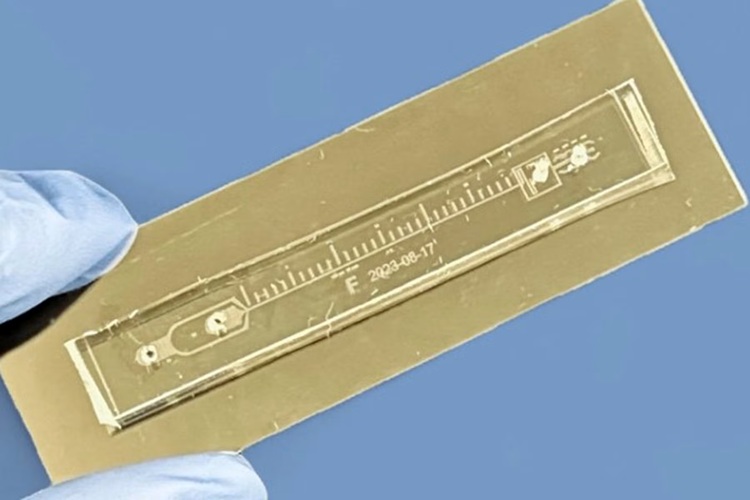Sensitive Nanozyme Test May Provide Rapid Point-of-Care Diagnosis of Ebola
|
By LabMedica International staff writers Posted on 24 Sep 2015 |

Image: In the new nanozyme immunochromatographic strip test for Ebolavirus (EBOV), the magnetic (A) and catalytic (B) properties of the nanozymes (Fe3O4 magnetic nanoparticles (MNPs)) make the signal 100 times stronger than standard strips with colloidal-gold nanoparticles, generating a deeper color reaction that can be more clearly seen by the naked eye (Image courtesy of Duan D et al., 2015, and Elsevier).
Researchers have developed a simple low-cost Ebolavirus (EBOV) test based on detection technology using magnetic nanoparticles that has shown 100x higher sensitivity than the standard immunochromatographic ELISA gold strip test.
In a new study led by Xiyun Yan, professor at the Institute of Biophysics, Chinese Academy of Sciences (Beijing, China), a nanozyme strip test was developed that is similar to the gold strip test but instead uses Fe3O4 magnetic nanoparticles (nanozymes) that enhance the signal via their intrinsic enzyme-like activity. Results showed 100x higher sensitivity than the gold strip test—the new test detects EBOV glycoprotein at concentrations as low as 1 nanogram/mL. Also, to concentrate the virus particles in the sample, the tube bottom is simply held against a magnet, so no expensive lab equipment is needed.
Early accurate detection is a key to controlling the Ebola outbreak as patients can then be isolated and treated. Current tests are either too expensive to be useful where they are most needed, or not sensitive enough to provide accurate diagnosis. PCR testing is highly sensitive but expensive and complicated, requiring specialized skills and equipment. Testing with the ELISA gold strip is inexpensive, but sensitivity is low.
“Our new strip test is a simple, one-step test that is cheap and easy to use, and provides a visible signal, which means people don’t need training to use it. We think it will be especially helpful in rural areas,” said Prof. Yan, “We’re very excited about our new nanozyme test, as it is much more sensitive and you don’t need any specialist equipment to get a quick, accurate result.” Her colleagues at the Chinese Center for Disease Control and Prevention (CDC) will field-test it in West Africa for its EBOV diagnostic and screening potential. The researchers are also developing automatic equipment to reduce risk of test contamination from hand-contact.
The nanozyme test is the result of an interdisciplinary collaboration of scientists and clinicians. The researchers are collaborating to develop this robust technology further as it can be applied for detection of other biological molecules, making it useful to diagnose additional infectious diseases and to potentially detect cancer tumors. It is also being tested for its potential to help in decontamination for wastewater treatment.
“We had an idea and talked to many people about it, and the result is a test that will overcome a problem,” said Prof. Yan, “We have built strong collaborations that have finally made this method successful, and we’re looking forward to applying it to many other areas.”
The study, by Duan D et al., was published online ahead of print 11 May 2015, in the journal Biosensors and Bioelectronics.
Related Links:
Chinese Academy of Sciences
Elsevier
In a new study led by Xiyun Yan, professor at the Institute of Biophysics, Chinese Academy of Sciences (Beijing, China), a nanozyme strip test was developed that is similar to the gold strip test but instead uses Fe3O4 magnetic nanoparticles (nanozymes) that enhance the signal via their intrinsic enzyme-like activity. Results showed 100x higher sensitivity than the gold strip test—the new test detects EBOV glycoprotein at concentrations as low as 1 nanogram/mL. Also, to concentrate the virus particles in the sample, the tube bottom is simply held against a magnet, so no expensive lab equipment is needed.
Early accurate detection is a key to controlling the Ebola outbreak as patients can then be isolated and treated. Current tests are either too expensive to be useful where they are most needed, or not sensitive enough to provide accurate diagnosis. PCR testing is highly sensitive but expensive and complicated, requiring specialized skills and equipment. Testing with the ELISA gold strip is inexpensive, but sensitivity is low.
“Our new strip test is a simple, one-step test that is cheap and easy to use, and provides a visible signal, which means people don’t need training to use it. We think it will be especially helpful in rural areas,” said Prof. Yan, “We’re very excited about our new nanozyme test, as it is much more sensitive and you don’t need any specialist equipment to get a quick, accurate result.” Her colleagues at the Chinese Center for Disease Control and Prevention (CDC) will field-test it in West Africa for its EBOV diagnostic and screening potential. The researchers are also developing automatic equipment to reduce risk of test contamination from hand-contact.
The nanozyme test is the result of an interdisciplinary collaboration of scientists and clinicians. The researchers are collaborating to develop this robust technology further as it can be applied for detection of other biological molecules, making it useful to diagnose additional infectious diseases and to potentially detect cancer tumors. It is also being tested for its potential to help in decontamination for wastewater treatment.
“We had an idea and talked to many people about it, and the result is a test that will overcome a problem,” said Prof. Yan, “We have built strong collaborations that have finally made this method successful, and we’re looking forward to applying it to many other areas.”
The study, by Duan D et al., was published online ahead of print 11 May 2015, in the journal Biosensors and Bioelectronics.
Related Links:
Chinese Academy of Sciences
Elsevier
Latest Microbiology News
- Rapid Assay Identifies Bloodstream Infection Pathogens Directly from Patient Samples
- Blood-Based Molecular Signatures to Enable Rapid EPTB Diagnosis
- 15-Minute Blood Test Diagnoses Life-Threatening Infections in Children
- High-Throughput Enteric Panels Detect Multiple GI Bacterial Infections from Single Stool Swab Sample
- Fast Noninvasive Bedside Test Uses Sugar Fingerprint to Detect Fungal Infections
- Rapid Sepsis Diagnostic Device to Enable Personalized Critical Care for ICU Patients
- Microfluidic Platform Assesses Neutrophil Function in Sepsis Patients
- New Diagnostic Method Confirms Sepsis Infections Earlier
- New Markers Could Predict Risk of Severe Chlamydia Infection
- Portable Spectroscopy Rapidly and Noninvasively Detects Bacterial Species in Vaginal Fluid
- CRISPR-Based Saliva Test Detects Tuberculosis Directly from Sputum
- Urine-Based Assay Diagnoses Common Lung Infection in Immunocompromised People
- Saliva Test Detects Implant-Related Microbial Risks
- New Platform Leverages AI and Quantum Computing to Predict Salmonella Antimicrobial Resistance
- Early Detection of Gut Microbiota Metabolite Linked to Atherosclerosis Could Revolutionize Diagnosis
- Viral Load Tests Can Help Predict Mpox Severity
Channels
Clinical Chemistry
view channel
Chemical Imaging Probe Could Track and Treat Prostate Cancer
Prostate cancer remains a leading cause of illness and death among men, with many patients eventually developing resistance to standard hormone-blocking therapies. These drugs often lose effectiveness... Read more
Mismatch Between Two Common Kidney Function Tests Indicates Serious Health Problems
Creatinine has long been the standard for measuring kidney filtration, while cystatin C — a protein produced by all human cells — has been recommended as a complementary marker because it is influenced... Read moreMolecular Diagnostics
view channel
New Genetic Test Enables Faster Diagnosis of Rare Diseases
Rare disease diagnosis often involves a long and uncertain search for the underlying genetic cause. Traditional testing requires multiple separate analyses, although many patients remain without answers.... Read more
Urine Test Detects Inherited Neuropathy Missed by Genetic Screening
Sorbitol dehydrogenase (SORD)-related neuropathy is one of the most common inherited nerve disorders, yet diagnosis often lags because current genetic screens frequently miss the causal gene.... Read moreHematology
view channel
Platelet Activity Blood Test in Middle Age Could Identify Early Alzheimer’s Risk
Early detection of Alzheimer’s disease remains one of the biggest unmet needs in neurology, particularly because the biological changes underlying the disorder begin decades before memory symptoms appear.... Read more
Microvesicles Measurement Could Detect Vascular Injury in Sickle Cell Disease Patients
Assessing disease severity in sickle cell disease (SCD) remains challenging, especially when trying to predict hemolysis, vascular injury, and risk of complications such as vaso-occlusive crises.... Read more
ADLM’s New Coagulation Testing Guidance to Improve Care for Patients on Blood Thinners
Direct oral anticoagulants (DOACs) are one of the most common types of blood thinners. Patients take them to prevent a host of complications that could arise from blood clotting, including stroke, deep... Read moreImmunology
view channel
Chip Captures Cancer Cells from Blood to Help Select Right Breast Cancer Treatment
Ductal carcinoma in situ (DCIS) accounts for about a quarter of all breast cancer cases and generally carries a good prognosis. This non-invasive form of the disease may or may not become life-threatening.... Read more
Blood-Based Liquid Biopsy Model Analyzes Immunotherapy Effectiveness
Immunotherapy has revolutionized cancer care by harnessing the immune system to fight tumors, yet predicting who will benefit remains a major challenge. Many patients undergo costly and taxing treatment... Read morePathology
view channel
Blood Test and Sputum Analysis Predict Acute COPD Exacerbation
Chronic obstructive pulmonary disease (COPD) remains a major contributor to global illness, largely driven by cigarette smoking and marked by irreversible lung damage. Acute exacerbations can accelerate... Read more
AI Tool to Transform Skin Cancer Detection with Near-Perfect Accuracy
Melanoma continues to be one of the most difficult skin cancers to diagnose because it often resembles harmless moles or benign lesions. Traditional AI tools depend heavily on dermoscopic images alone,... Read more
Unique Immune Signatures Distinguish Rare Autoimmune Condition from Multiple Sclerosis
Myelin oligodendrocyte glycoprotein antibody–associated disease (MOGAD) is a rare autoimmune disorder in which the immune system attacks the myelin sheath in the central nervous system. Although symptoms... Read moreTechnology
view channel
AI Saliva Sensor Enables Early Detection of Head and Neck Cancer
Early detection of head and neck cancer remains difficult because the disease produces few or no symptoms in its earliest stages, and lesions often lie deep within the head or neck, where biopsy or endoscopy... Read more
AI-Powered Biosensor Technology to Enable Breath Test for Lung Cancer Detection
Detecting lung cancer early remains one of the biggest challenges in oncology, largely because current tools are invasive, expensive, or unable to identify the disease in its earliest phases.... Read moreIndustry
view channel
Abbott Acquires Cancer-Screening Company Exact Sciences
Abbott (Abbott Park, IL, USA) has entered into a definitive agreement to acquire Exact Sciences (Madison, WI, USA), enabling it to enter and lead in fast-growing cancer diagnostics segments.... Read more




 assay.jpg)



















